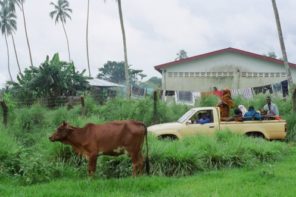“We are an intelligence and analysis company that forecasts. We are not a news organisation that tells stories. We are not political scientists who explain. We do a little of both, but our raison d’être is to forecast the outcome of various risk scenarios. We rate risk level, but the real value is to give the client an actionable forecast against which to invest.” Introduction to SFS and Style Guidance: Principles of Analysis
Commercial risk forecasting is an altogether still rather under-explored economic growth activity, providing commodified expert analysis about future risks to clients ranging from insurance, banking, extractive industries, government and defence, logistics, to INGOs. Producing forecasts about an uncertain future, commercial intelligence providers promise clients to give them the information they need to mitigate risks to their ventures, investments, and personnel. Risk forecasting follows its own rules and logic to identify, select, and process evidence, the output of which becomes a new form of upstream, pre-processed evidence for industries and spheres of activity we know from the literature on indicators, risk, and technicalisation.
This essay looks at the temporal nature of evidence in commercial futurology. What are the evidentiary practices put in place to socially produce forecasts about the future from current and past, ‘risk-relevant events’?[1] What are the consequences of specific regimes of evidence for the nature of this evidence, and what new insights into the nature of globalised capitalism can be gained from investigating future evidence as a knowledge-making practice in its own right?
As Christina Boswell convincingly demonstrates in her detailed deconstruction of ‘evidence-based policy-making’, expert evidence works primarily in symbolic ways: it is not so much the content of knowledge that is being valued, and which is used to shape policy decisions, but rather that the display of this evidence signals the credibility and authority of an organisation or entity and its policies (2009, 8). Under an evidence-based approach to policy-making, analyses and predictions are thus used to justify decisions ex post, under the pretence that they preceded the decisions, thus masking the usually deeply ideological nature of such decisions under a veneer of technicality.[2] But what happens in the case of commercial risk forecasting, when the forecasts are truly produced ‘upstream’, or prior to the developments and events that they purport to predict?
I would argue that despite the temporally preceding, extraneous, ‘granular’ knowledge that feeds into these forecasts, the temporal modalities of production of risk briefs ultimately contribute to the circularity of knowledge-production in globalised late capitalism.
My reflections here are based on five years of work experience as Senior Africa Analyst with a London-based, ‘boutique’ risk forecasting company that I call Select Forecasting Services (hereafter SFS) here.[3] As SFS originated as a service to the insurance industry, its understanding of risk was from the outset very much shaped by these client interests, and structured the ‘forecastable’ political and violent risks in categories that corresponded to specific types of insurance.[4] As evinced in the opening quote above, the main daily task of analysts was to choose the event, identify the risk it presented, formulate a risk scenario based on this, distil this information into a 300-word, ‘actionable’ forecast for clients, and adjust assigned risk scores accordingly.
These daily briefs, in addition to weekly forecasts and a database of standing country forecasts, were SFS’s core business. The first step in the production of these briefs meant selecting from recent risk-relevant events those that would affect client interests by changing the outlook for a specific type of risk for a certain country, area, or industry. A high-risk, high-probability event (a military coup, or asset confiscation, e.g.) almost certainly warranted a brief, but in many cases it was not so clear-cut. I thus had to learn to adopt a client-focused mindset that privileged events relevant to their interests (tax reforms, e.g.), and disregard events that spoke more to my own anthropological sensibilities (any ‘social unrest’ that did not directly result in property damage, e.g.).
In any case, it meant framing developments in a perspective of potential impact on client interests. Once an event was selected as worthy of a forecast, the task of the analyst was then to condense all the available information into a 300-word, ‘actionable’ daily brief, based on the risk-relevant event, and the analyst’s knowledge of the context and the historical precedent. Here I also quickly learned that there was little patience for overly sophisticated or nuanced background analyses.
Indeed, although I was hired for my country expertise, my knowledge was only valuable in very selective and specific ways, and had to be rendered ‘intelligible’ to the requirements of risk forecasting.
The daily back-and-forth between analysts, desk, auditors, and sub-editors refined draft briefs into actionable and unambiguous forecasts. Rather than focusing on these social processes of co-production that transformed freely available news items into proprietary, commercially valuable forecasts, thereby contributing to the accelerating privatisation of the digital commons, let me here turn to the evidentiary practices at play.
Although ‘evidence’ as such was not part of the everyday vocabulary of work, we can identify two different registers of evidence-making in practice: one is the transformation, through internal processes of selection, of open-source reports on events (facts) into risk-relevant events that serve as a basis (evidence) for the analysis and production of forecasts. The other is the production of the actual forecasts, or ‘evidence for the future’, whereby facticity is produced by the internal processes of vetting and auditing. These together can be analysed as the evidentiary practices of commercial futurology, where, I would argue, their relation in and with time is key.
Forecasts condense different temporalities: the historical precedent, present events, and future developments are pulled together into a brief, which flattens out a complex, multi-temporal social, political, and economic topography into a highly utilitarian routemap of events yet to come.
In that sense, the forecast could be seen as a trans-temporal hinge, a ‘configuration of socio-cultural life that is imbued with the capacity for bringing together phenomena that are otherwise distributed across disparate moments in time’ (Pedersen and Nielsen 2013, 123–124). However, while such forecasts do indeed appear to allow for the ‘co-existence of different temporalities […] as overlapping tendencies in the present’ (124), the forecast taken at face value derives its whole raison d’être precisely from its production prior to the anticipated future following a linear notion of time. And yet, due to the modalities of their production — the evidentiary practices put in place to produce ‘accurate’ and ‘actionable’ forecasts — the idea of recurrence, or temporal circularity also applies.
For when does a ‘fact’ normally become ‘evidence’? When the fact has been verified, proven, by whichever evidentiary protocols govern that specific domain (cf. Chua, High, and Lau 2008). In the case of SFS, events are made risk-relevant as they happen, when they are selected. Forecasts, however, are evidence for the future only qua their having been vetted by the internal process of selection, processing, publication, and quantification — verification, i.e. ‘material proof’, can only happen after the fact. The fiction of facticity is thus projected (and admittedly so) in the future tense.
If the forecast is accurate and the predicted development comes to pass, its evidentiary nature shifts, from being the result of the technocratic production of ‘evidence for the future’ according to jealously guarded internal analysis and audit processes, to becoming ‘material’ evidence in a chain of risk-relevant events, which in turn serve as the basis for the production of new forecasts. In the very same moment it is validated by the events, the forecast loses its entire commercial value, as it is transformed from a proprietary form of knowledge — evidence for the future — into freely available data, or simple facts.
The forecast — evidence, in emic terms — only has value in the future tense.
This is also true if a forecasted event does not come to pass, or happens in a different way than forecasted. Because the ‘standing country briefs’ are regularly updated, too, the past is subject to rewriting, to get the past ‘protospectively’ (cf. Pedersen & Nielsen 2013) to fall in line with the new, unfolding futures. This is in many ways the qualitative equivalent to the quantitative ‘yield curve’, a mathematical model of projected future returns, constantly adjusted by automated market inputs, and used by financial traders, where ‘the past enters as a set of former predictions’ (Zaloom 2009, 260). In the case of risk forecasting, the speculative former future, only made ‘true’ by internal evidentiary practices, becomes a proven, factual, past event in a constantly updated chain of risk-relevant events that feeds into the production of new evidence for the future.
One of the consequences of this is that forecasts have a reverse explanatory power — rather than making a case for ‘resource-based conflicts’,[5] forecasts could be said to contribute to the production of ‘conflict-based resources’. In the most extreme, this takes the form of betting against the market, as we know it from literature on risk and financial markets (or in fictionalised form), but it also works in much less obvious, perhaps more insidious ways. Sally Merry has demonstrated how the rise of indicators as tools of global governance ‘facilitate governance by self-management,’ as countries and entities are made responsible for their compliance with the criteria for good performance set out by an indicator (2011, S85). But while it is accurate to say that the ‘explosion of rankings and audit culture’ pushes the audited towards compliance, producing a ‘hierarchical reputation economy’ with often ‘perverse outcomes’ (Gilbert 2015, 85), in the case of risk forecasting the risk indicators are normally not known to the audited (countries, in this case).
Compare this with the outcry of governments when the big financial ratings agencies downgrade their risk ratings: this is understandable and justified, given how such an adjustment will raise the costs for a country to issue sovereign debt. But arguably a raise in political or violent risk ratings has equally direct knock-on effects, with investors suspending or reconsidering their investments, or service providers and insurers adjusting their prices and premiums — while the cause for such effects remains largely unknown to the target countries.
In fact, the only instance where protests against a forecast were lodged was usually when the information contained therein might have negatively affected the standing of a commercial actor in a separate, enclosed arena where such a hierarchical reputation economy comes into play again — the stock market, for example. A forecast considering hypothetical risks to a certain mining company’s railway line in a specific Central African country might send said company’s share prices on a downward trajectory, if traders and shareholders have access to the same brief. In that sense, the success of SFS — the broadening of its customer base — has important consequences for how risk-relevant evidence is defined, which ultimately resulted in a weakening and diluting of its forecasts, as less and less specifics could be mentioned without the concerned entities intervening and threatening, in the worst case, a libel suit.
The rise of commercial intelligence providers, and more specifically, of risk forecasting, is a consequence both of a ‘heightened ontological insecurity’ about the future — the immediacy of event and effect on a global scale that makes it increasingly difficult to establish a predictable relationship between present action and future consequences (Reith 2004), and the economic potential of colonising the terrain of the unknowable ‘near future’ for stupendous monetary gains, i.e. the productive life of risk (Zaloom 2004; 2007). Where ‘risk is mitigated by smartness’ (Ho 2010, 5), expert knowledge about the future is basically a guide to action, reassuring customers in their own decisions (Rottenburg et al. 2015, 2–3; Reith 2004, 395). However, more than only providing a routemap to future risks, I would suggest that the rise of ‘audit cultures’ (Strathern 2000) inside companies plays an at least equally important role in how such evidence for the future is consumed, which shows evident parallels to Boswell’s argument about the validating, symbolic role of evidence in policy-making: investors, corporate risk managers, and insurance underwriters need to be able to demonstrate that they have consulted ‘expert opinion’, which then allows them to proceed with their business (often as previously decided) mitigating against internal fallout in case the risk actually came about.
I would thus suggest that although risk forecasting derives its entire commercial value from ‘thinking outside the box’ and ‘foreseeing the unforeseeable’ for its clients, a ‘feedback loop’ between future and past events is hardwired into its evidentiary practices. While this makes the forecast more ‘accurate’, it ultimately reinforces rather than challenges the dominant economistic modes of thought that mould the way corporate actors understand and act upon present social realities.
Notes:
[1]. As such it builds upon an earlier conference presentation on the social production of risk scores assigned to given ‘actionable forecasts’.
[2]. Although more recently, political decisions seem to have dispensed with the pretence of verifiable facts altogether — cue Brexit.
[3]. That company no longer exists as a legal entity, having been bought up and incorporated as a new internal division by a multinational commercial intelligence provider.
[4]. The categories were: property damage, death and injury, kidnap and ransom, civil war, interstate war, terrorism, and protests and riots for violent risk, as well as regime stability, currency, taxation, regulatory, CEND (Confiscation, Expropriation, Nationalisation, Deprivation), and labour unrest (strike action) for political risk.
[5]. A still dominant line of thought in media reports and something more poststructuralist analysts of the political economy of conflict have been writing against most forcefully over the past 15 or so years.
References:
Boswell, Christina. 2009. The Political Uses of Expert Knowledge: Immigration Policy and Social Research. Cambridge; New York: Cambridge University Press.
Chua, Liana, Casey High, and Timm Lau. 2008. “Introduction: Questions of Evidence.” In How Do We Know? Evidence, Ethnography, and the Making of Anthropological Knowledge, edited by Liana Chua, Casey High, and Timm Lau, 1–19. Newcastle: Cambridge Scholars Publishing.
Gilbert, Paul Robert. 2015. “Commentary: The Ranking Explosion.” Social Anthropology 23 (1): 83–86. doi:10.1111/1469-8676.12104.
Ho, Karen Z. 2010. “Outsmarting Risk: From Bonuses to Bailouts.” Anthropology Now 2 (1): 1–9.
Merry, Sally Engle. 2011. “Measuring the World: Indicators, Human Rights, and Global Governance.” Current Anthropology 52 (S3): S83–S95. doi:10.1086/657241.
Pedersen, Morten Axel, and Morten Nielsen. 2013. “Trans-Temporal Hinges: Reflections on an Ethnographic Study of Chinese Infrastructural Projects in Mozambique and Mongolia.” Social Analysis 57 (1): 122–142. doi:10.3167/sa.2013.570109.
Reith, Gerda. 2004. “Uncertain Times The Notion of ‘Risk’ and the Development of Modernity.” Time & Society 13 (2–3): 383–402. doi:10.1177/0961463X04045672.
Rottenburg, Richard, Sally Engle Merry, Sung-Joon Park, and Johanna Mugler, eds. 2015. The World of Indicators: The Making of Governmental Knowledge through Quantification. Cambridge University Press.
Strathern, Marilyn, ed. 2000. Audit Cultures: Anthropological Studies in Accountability, Ethics, and the Academy. Psychology Press.
Zaloom, Caitlin. 2004. “The Productive Life of Risk.” Cultural Anthropology 19 (3): 365–391. doi:10.1525/can.2004.19.3.365.
Zaloom, Caitlin. 2007. “Future Knowledge.” American Ethnologist 34 (3): 444–446.
Zaloom, Caitlin. 2009. “How to Read the Future: The Yield Curve, Affect, and Financial Prediction.” Public Culture 21 (2): 245–268. doi:10.1215/08992363-2008-028.











